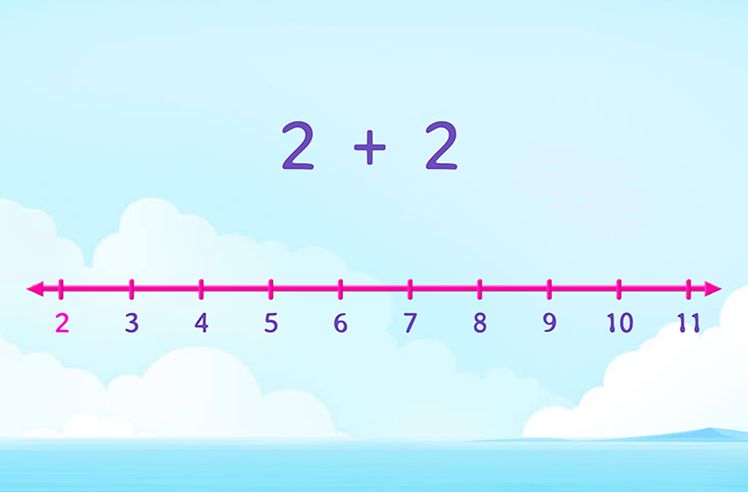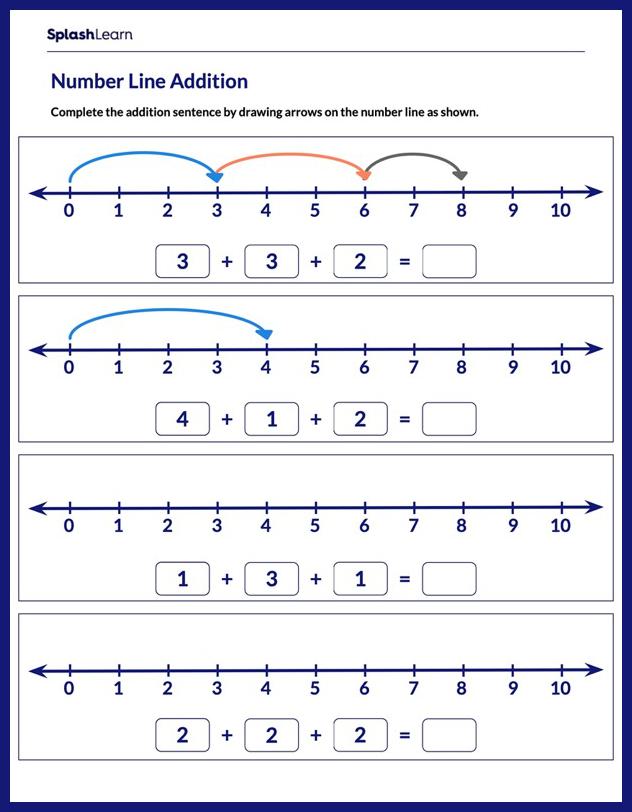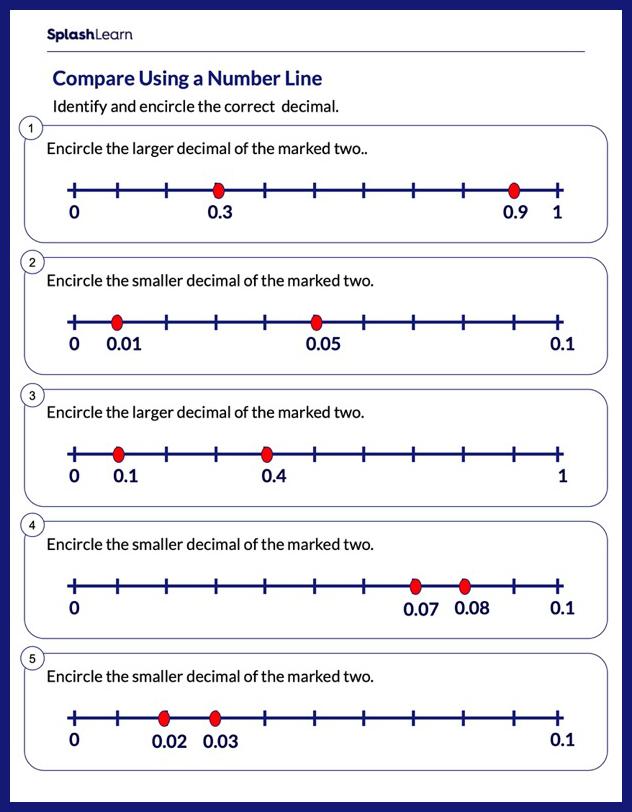- What Is the Distance between a Point and a Line?
- Distance from a Point to a Line Definition in Geometry
- How to Find the Distance Between Point and Line
- Solved Examples on Distance between Point and Line
- Practice Problems on Distance Between Point and Line
- Frequently Asked Questions on the Distance between Point and Line
What Is the Distance between a Point and a Line?
The distance between point and line is the shortest distance between the point and the straight line.
Consider a line BF and a point A as shown in the diagram below. We can draw an infinite number of line segments from the line to the point A. So, what is the actual distance between the given line and the point A?
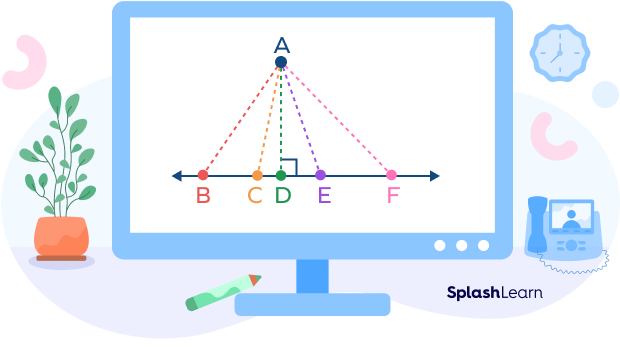
It is the shortest distance from A to the line. How can we find this shortest distance? The shortest distance from a point and a line is the length of the perpendicular drawn from the point to the line. Thus, the line segment AD defines the distance between the point and a line.
Recommended Games
Distance from a Point to a Line Definition in Geometry
The distance between point and line is the shortest distance between the point and a point on the line. The length of a perpendicular drawn from a point to a point on the line defines the shortest distance between them.
Recommended Worksheets
Distance from Point to Line Formula
The distance between point and line for a line $Ax + By + C = 0$ and a point with the coordinates $(x₀, y₀)$ is calculated by the following formula
$d = \frac{| Ax₀ + By₀ + C |}{\sqrt{A² + B²}}$
where,
A, B, and C are real numbers.
A and B cannot be equal to zero.
The formula has an absolute zero or modulus sign in the numerator which indicates that the value of the numerator would always be a positive number or zero.
How to Find the Distance Between Point and Line
Step 1: Compare the given equation of a line with the standard equation $Ax + By + C = 0$ to find the values of A, B, and C.
Step 2: Compare the coordinates of the given point with $(x₁, y₁)$ to find the values of $x₁$ and $y₁$.
Step 3: Substitute the values in the formula
$d = Ax₁ + By₁ + CA² + B²$
Perpendicular Distance from Point to Line
The shortest distance between point and line is calculated by finding the length of the perpendicular drawn from the point to the line.
Consider the line l: $Ax + By + C = 0$ and point $P(x₁, y₁)$.
Note that PQ is the perpendicular from point P to line l. Let l$(PQ) = d$.
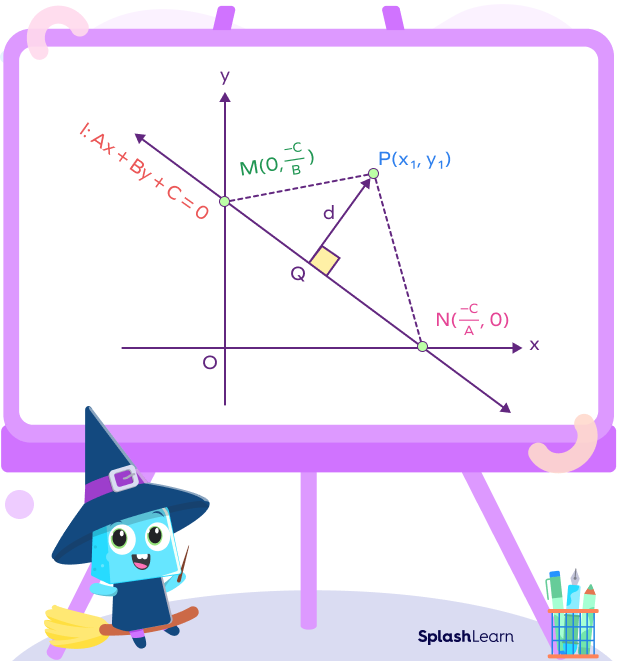
M and N are the points of intersection of the line on the x-axis and y-axis.
M is the y-intercept of line l. Putting $x = 0$ in $Ax + By + C = 0$, we get $y = \;-\;\frac{C}{B}$.
Thus, $M \equiv (0, \;-\;\frac{C}{B})$
N is the x-intercept of line l. Putting $y = 0$ in $Ax + By + C = 0$, we get $x = \;-\;\frac{C}{A}$.
Thus, $N \equiv (\;-\;\frac{C}{A},\; 0)$.
Here, PQ is the height of the triangle PMN. We use the formula of area of triangle and the distance formula to derive the formula for perpendicular distance between point and line.
Derivation of the Distance from Point to Line
We have
l: $Ax + By + C = 0$ and $P(x₁,\; y₁)$
$M \equiv (0,\; -\;\frac{C}{B})$
$N \equiv (\;-\;\frac{C}{A},\; 0)$
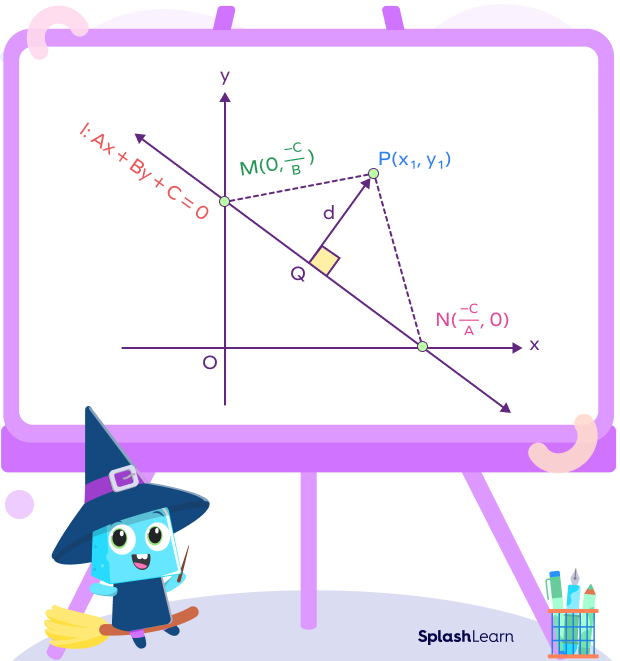
To find: distance between point P and line l, which is defined by the length d or length(PQ)
As mentioned earlier, PQ is the height of the $\Delta PMN$.
The formula for the area of a triangle is given by
Area of triangle $= \frac{1}{2} \times$base $\times$ height
Area of PMN $= \frac{1}{2}\times$ MN $\times$ PQ
$\Rightarrow PQ = \frac{Area\; of\; \Delta PMN \times 2}{AB}$ ———— (i)
Let’s find these two values on the R.H.S.
According to coordinate geometry, the area of PMN can be given as
$Area of \Delta PMN = \frac{1}{2} |x₁(y₂\;-\;y₃) + x₂(y₃\;-\;y₁) + x₃( y₁\;-\;y₂)|$
$= \frac{1}{2} |x₁(0\;-\;(\;-\;\frac{C}{B})) + (\;-\;\frac{C}{A})((\;-\;\frac{C}{B})\;-\;y₁) +0( y₁\;-\; 0)$
$= \frac{1}{2} | \frac{x₁C}{B} +(\frac{-C}{A})(\frac{-C \;-\; By₁}{B})|$
$= \frac{1}{2} | \frac{x₁C}{B} + (\frac{C²}{AB} + \frac{BCy₁}{AB})|$
$= \frac{1}{2} |\frac{x₁C}{B} + \frac{Cy₁}{A} + \frac{C²A}{B})|$
$= \frac{1}{2}| C(\frac{x₁}{B} + \frac{y₁}{A} + \frac{C}{AB})|$ ————- (ii)
Multiple and divide the equation (ii) by AB
$Area\; of\; \Delta PMN = \frac{1}{2} |C(\frac{ABx₁}{AB²} + \frac{ABy₁}{A²B} + \frac{ABC}{A²B²})|$
$= \frac{1}{2} |\frac{CAx₁}{AB} + \frac{CBy₁}{AB} + \frac{C²}{AB})|$
$= \frac{1}{2} |\frac{C}{AB}| (Ax₁ + By₁ + C)$ ————– (iii)
Next, the distance of the line AB with coordinates $M(x₁,\; y₁)$ and $N(x₂,\; y₂)$ can be given by distance formula as $MN = \sqrt{((x₂ \;-\; x₁)²+ (y₂ \;-\;y₁)²)}$
In our case, $M(x₁,\; y₁) = (0,\; -\;\frac{C}{B})$ and $N(x₂,\; y₂) = (\;-\;\frac{C}{A},\; 0)$
$MN = \sqrt{((\;-\;\frac{C}{A}) \;-\; 0)² + (0 \;-\; (\;-\;CB))²)}$
$MN = \sqrt{(\;-\;CA)² + (CB)²)}$
$MN = |\frac{C}{AB}| (A² + B² )$ ————- (iv)
Substituting equations (ii) and (iv) in equation (i)
$PQ = \frac{1}{2} \times \frac{|\frac{CA}{B}| (Ax₁ + By₁ + C) \times 2}{|\frac{C}{AB}| (\sqrt{A²+ B²})$
$PQ = d = \frac{|(Ax₁ + By₁ + C)|}{\sqrt{A² + B²}}$
Hence, we get that the distance between a point $(x₁,\; y₁)$ and a line $Ax + By + C = 0$ is given
$d = \frac{|(Ax₁ + By₁ + C)|}{\sqrt{A² + B²}}$
Facts about the Distance between Point and Line
- The distance between a point and a line can never be negative.
- The formula for distance between point and line has many practical applications in map navigation, construction, and sports.
- The distance between origin and a line $Ax + By + C = 0$ is $d = \frac{|C|}{\sqrt{A² + B²}}$.
Conclusion
The distance between point and line is a basic yet essential concept in coordinate geometry. We learned about the formula for finding the distance between a point and a line along with its derivation. Let’s solve a few examples.
Solved Examples on Distance between Point and Line
Example 1: Find the distance between the point (0, 0) and the line $4x \;-\; 3y + 25 = 0$.
Solution:
We have $P(x₁,\; y₁) = (0, 0)$ and the line $4x \;-\; 3y + 25 = 0$
$x₁ = 0$ and $y₁ = 0$
$A = 4,\; B = \;-\;3,\; C = 25$
Using the formula for distance between point and line,
$d = \frac{|(Ax₁ + By₁ + C)|}{\sqrt{A² + B²}}$
$d = \frac{(4 \times 0) + (\;-\;3 \times 0)+ 25|}{sqrt{4² + (\;-\;3)²}}$
$d = \frac{|0 + 0 + 25|}{\sqrt{16 + 9}}$
$d = \frac{25}{\sqrt{16 + 9}}$
$d = \frac{25}{\sqrt{25}}$
$d = \frac{25}{5}$
$d = 5$ units
Example 2: Find the distance between the point $(4,\; 6)$ and line $y = \frac{1}{3}x \;-\; 3$.
Solution:
$(4,\; 6) = (x₁,\; y₁)$
$x1 = 4,\; y1 = 6$
$y = \frac{1}{3}x \;-\; 3$
Add 3 on both sides of the equation.
$y + 3 = \frac{1}{3}x \;-\; 3 + 3$
$y + 3 = \frac{1}{3}x$
$\frac{1}{3}x \;-\; y + 3 = 0$
Multiply both sides of the equation by 3
$x \;-\; 3y + 9 = 0$ ———- (i)
Comparing equation (i) with $Ax + By + C = 0$, we get
$A = 1,\; B = \;-\;3,\; C = 9$
Using the formula for distance between point and line
$d = \frac{|(Ax₁ + By₁ + C)|}{\sqrt{A² + B²}}$
$d = \frac{|(1 \times4) + (\;-\;3 \times 6) + 9|}{\sqrt{(\;-\;1)² + (3)²}}$
$d = \frac{|4 \;-\; 18 + 9|}{1 + 9}$
$d = \frac{|\;-\;18 + 13|}{\sqrt{10}}$
$d = \frac{5}{\sqrt{10}}$
$d = \frac{5}{\sqrt{10}}$ units
Example 3: Find the distance between point P(6, 9) and line $2x \;-\; 5y + 7 = 0$.
Solution:
$P(6,\; 9): x1 = 6,\; y1 = 9$
Comparing equation (i) with $Ax + By + C = 0$, we get
$A = 2,\; B = \;-\;5, C = 7$
Using the formula for distance between point and line
$d = \frac{|(Ax₁ + By₁ + C)|}{\sqrt{A² + B²}}$
$d = \frac{|(2 \times 6) + (- 5 \times 9) + 7|}{\sqrt{(2)² + (\;-\;5)²}}$
$d = \frac{|12 – 45 + 7|}{\sqrt{4 + 25}}$
$d = \frac{|\;-\;45 + 19|}{\sqrt{29}}$
$d = \frac{|\;-\;26|}{\sqrt{29}}$
$d = \frac{26}{\sqrt{29}}$
$d = \frac{26}{\sqrt{29}}$ units
Practice Problems on Distance Between Point and Line
Distance between Point and Line: Formula, Definition, Examples
Find the distance between the point (0, 7) and line $3x + 2y \;-\; 4 = 0$.
$A = 3,\; B = 2,\; C = \;-\;4; (x₁,\; y₁) = (0,\; 7)$
$d = \frac{|(Ax₁+ By₁+C)|}{\sqrt{A² + B²}} = \frac{|(3(0)+ 2(7) \;-\;4)|}{\sqrt{3² + 2²}} = \frac{10}{\sqrt{13}}$
What is the formula for finding the distance between a point$ (x₁, y₁)$ and a line $Ax + By + C = 0$?
The formula for finding the distance between a point $(x₁,\; y₁)$ and a line $Ax + By + C = 0$ is
$d= \frac{|(Ax₁ + By₁ + C)|}{\sqrt{A² + B²}}$
The distance of the point (0, 1) from x-axis is
Equation of x-axis: $y = 0$
Comparing with $Ax + By + C = 0$, we get $A = 0,\; B = 1,\; C = 0$
Point $= (0,\; 1)$
Thus, $d = \frac{|0 + (1)(1) + 0|}{\sqrt{0 + 1}} = 1$ unit
What is the distance of the point (1, 0) from the line $x = 1$?
The point (1, 0) lies on the line $x = 1$ since it satisfies the equation.
Thus, the distance between $(1,\; 0)$ and the line $x = 1$ is 0.
Frequently Asked Questions on the Distance between Point and Line
What is the shortest distance between a point and a line?
It is the length of a perpendicular drawn from the point to the line.
What is the distance formula?
The distance between two points is the length of the line segment that connects them on a plane. The formula is $d = ((x_2 \;-\; x_1)^2 + (y_2 \;-\;y_1)^2)$ , where $(x_1,\; y_1)$ and $(x_2,\; y_2)$ are the coordinates of the two points.
What is the equation for a straight line in the slop-intercept form?
The equation for a straight line in the slope point form is given by $y = mx + c$, where m is the slope and c is the y-intercept.
















